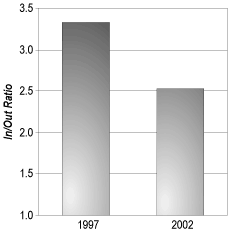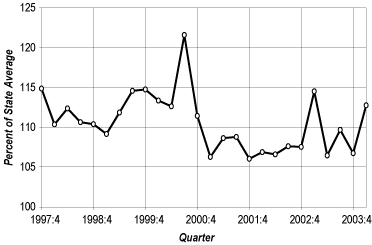Columbus
Kelley School of Business, Indiana University, Indianapolis
Candidates for political office all promise more jobs and more prosperity. In the real world, individual politicians don’t have much effect on the economy. Trends in economic activity typically take many years to develop, much longer than any politician’s term of office.
Trends emerging in Columbus and Bartholomew County, however, raise concerns. The Columbus metro has historically been one of Indiana’s more prosperous regions. Per capita personal income (PCPI) was 103 percent of the national average in 1997, fifth highest among Indiana’s ninety-two counties (see Figure 1). By 2002, though, per capita income had dropped below the national average (to 98 percent), and the county’s ranking in the state was down to ninth. That year was a recession year, of course, but it was a recession all over Indiana. Yet Bartholomew County’s ranking within Indiana went down.
Figure 1
Bartholomew County PCPI

This decline in relative prosperity is reflected in the wages earned in the county. Figure 2 shows quarterly wages per job in Bartholomew County as a percent of the Indiana state average. From its former level of more than 110 percent of the state average, the county drifted down to near 105 percent in the most recent five years. (The spike in 2000 may have been influenced by the ArvinMeritor merger that year). What’s even more troubling is that in real terms, after adjusting for inflation, wages per job in the county are no higher than they were in 1998 and 1999.
Figure 2
Bartholomew County Real Wages per Job as a Percent of State
Recessions often hit hard in Bartholomew County. Heavy manufacturing has at times accounted for more than 40 percent of Bartholomew County employment, though now that figure has shrunk to 35 percent. But recoveries have been good to the area too. Not this time. The current economic recovery, a weak one nationally, has been even weaker in the Columbus area.
The level of employment is shown in Figure 3, indexed to the fourth quarter of 1997 in order to make a comparison to total employment in the state. While employment statewide declined during the recession in 2000 and 2001, by the end of 2001 the worst of the drop was over. In Bartholomew County, however, after a brief bounce in 2002, the downward trend in employment continued, widening the gap between the performance of Bartholomew County and that of Indiana as a whole. So far, whatever recovery that has taken place nationally has not boosted employment around Columbus very much.
Figure 3
Quarterly Payroll Employment Index

Bartholomew County businesses have long been a draw for residents of surrounding counties. The commuting patterns show far more people commuting into Bartholomew County to work than commuting out. But that pattern, too, is weakening. In 1997, the ratio of commuters into the county to commuters out of the county was 3.3 to 1 (see Figure 4). Three people drove into the county to work for every one Bartholomew County resident commuting to a job outside the county. By 2002, that ratio was down to 2.5 to 1. There were fewer inbound commuters and more people leaving the county to work.
Figure 4
Bartholomew County Commuting Ratio

These local trends indicate Bartholomew County’s economic climate in 2005 will not improve as much as the national average. And the outlook at the national level is for only lukewarm (and highly uncertain) expansion.
Some sectors of the Columbus area economy surely will do better than others. While real wages per job were flat countywide in the last five years, they grew by more than 30 percent in the financial services sector. And despite the recession, employment in health care jumped 10 percent from 2001 to 2004.
In general, though, don’t look for 2005 to be much different from 2004. Based on forecast data from the Kelley School of Business, here’s what to expect:
- General level of business activity: About the same as in 2004. Not much growth.
- Wages: Flat. Any increases will just about cover inflation.
- Number of jobs: Not much improvement over 2004. Countywide, an increase of perhaps 600 jobs, or about a 1.5 percent rise in payrolls.
- Unemployment rate: The average may be a little better than 2004. But the early months typically have the highest unemployment rate of the year. So expect the rate to approach 4 percent in the first quarter, improving to 3 percent by the fourth quarter.
Sources
Indiana Business Research Center, Kelley School of Business, Indiana University; U.S. Bureau of Economic Analysis; and the U.S. Census Bureau.
Also in this Issue…




